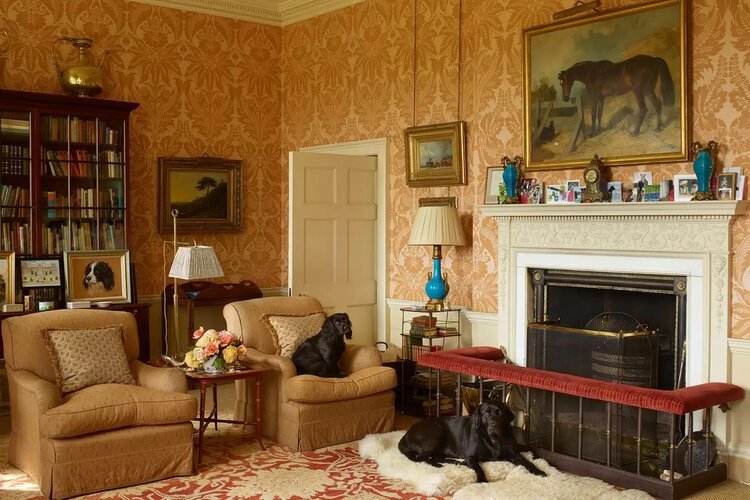The Historic Houses Association
Spencer House, St James's Place, London
The Historic Houses Association
WOOLF Interior Design & Interior Architecture have developed specialist skills through years of sensitively designing High End Interiors for Grade I or II listed and Historic buildings in commercial and residential settings. Our interior design work has led us to forge long standing professional relationships with English Heritage and consultants at ‘Historic England’ and ‘The Bath Preservation Trust’. As specialist designer of Georgian and other period properties, we have worked closely with surveyors at ‘The Grosvenor and Crown Estates’, several regional planning consultants, professional bodies and heritage trusts in London, Somerset, The Cotswold’s, Ireland and Internationally in Dubai and Moscow.
In our role as high end historic interior designers and interior architects in Bath and London, we have an opportunity to restore beautiful historic buildings and houses, in particular Georgian homes. to their original grandeur. Often we will be enhancing buildings to a contemporary brief so that they are fit for modern living and the lifestyles of our clients or guests. Explore WOOLF Historic Houses.
WOOLF Interior Design & Interior Architecture is a Member of the HHA
For WOOLF Interior Design & Interior Architecture, being aligned with the HHA (Historic Houses Association) has become a very important resource and touch point for our work on historic interiors. The UK has some of the finest and best ‘top end’ preserved historic houses, parks and gardens in the world, with most UK heritage independently owned.
Unlike the National Trust and English Heritage, Historic Houses Association represents these independently owned houses and offers members the chance to explore their stunning collections of art and architecture, which is what we why we love the ethos of the HHA.
Historic Houses: Lived in Family Homes
Unlike museums, Historic Houses are lived-in family homes, with resident families often able to trace their lineage there back hundreds of years. As members, we can now explore these ancient buildings which opens older spaces to a new generation. From the treasure houses of Harewood, Castle Howard and Hever Castle, to the hidden gems of Corsham Court, Hoveton Hall and Kelmscott Manor, they represent an extraordinary collection of the nation's finest and most diverse historic houses. Explore WOOLF Historic Houses.
Why Become A Member?
Nothing tells a nation's story like its homes. Every member of Historic Houses is helping to preserve Britain's independent heritage. As historic interior designers we have an opportunity to delve deeper into the histories and heritage of the local area of 300 historic buildings across the UK. Their collection includes the largest group of historic houses in the UK, and ranges from imposing castles and impressive palaces to elegant stately homes and hidden, sleepy, manor houses. From large to small, Medieval to Georgian and Victorian, most are lived-in family homes, not static museums. For WOOLF Interior Design & Interior Architecture, the yearly AGM has been a really useful forum of insights, ideas and future plans for many of the houses. Some of our most specialist craftsmen and suppliers show their work at the AGM.
Spencer House - Great Dining Room
Bowood House - Sitting Room
The HHA Community of Owners
Historic home owners have an opportunity to come together to speak with one voice, offer mutual aid and pool experiences and expertise, and encourage best practice, to ensure these historic homes stay alive and accessible. The HHA works to further research into historic houses and their collections, supporting these houses, keeping them safe advising owners on anything from rising damp, awarding those houses that have completed exceptional restorations, have wonderful gardens, or work tirelessly to excel in educational innovation of the ‘Next Generation Members’. Here are a few of our favorite HHA houses chosen by us for their staggering interiors:
Spencer House, St James's Place, London
Entrance - Spencer House, London
Palm Room - Spencer House, London
Spencer House, St James's Place, London - Sumptuous Private Residences
From its conception Spencer House was recognised as one of the most sumptuous private residences ever built in London and a building of unique importance in the history of English Georgian architecture.
Designed by John Vardy and James ‘Athenian’ Stuart, the State Rooms are amongst the first neo-classical interiors in Europe, which became the first example in London of the application of accurate Greek detail to interior decoration, making it one of the pioneer examples of neo-classical architecture.
The House has regained the full splendor of its eighteenth-century appearance after a painstaking ten-year restoration under the Chairmanship of Lord Rothschild. The restoration has enabled the return of some key pieces of furniture to their original locations, including Vardy’s elaborate giltwood console tables in the Dining Room and Stuart’s Painted Room suite, both on loan from the V&A, London.
The House was partly remodelled by the architect, Henry Holland who added the Greek Ionic columns in the Dining Room, encased in Siena scagliola, and the large mahogany doors in the Staircase Hall, the Ante Room and the Library. In the 1840s the ground floor was decorated and the first floor was restored by the famous Victorian architect, Philip Hardwick. Thirty years later the Parisian designer, Barbier, redecorated the ground floor rooms.
Emery Walker's House, Hammersmith, London
Emery Walker's House, Hammersmith, London - Arts & Crafts interiors
This house was a private home until 1999, it has the most complete and authentic Arts & Crafts interiors in the UK. The house includes hand blocked Morris & Co Wallpaper and textiles and Philip Webb furniture. The tall, terraced house on the River Thames at Hammersmith was home to the printer Emery Walker, friend and mentor to William Morris. The decoration and furnishings are preserved as they were in his lifetime.
The interior decoration is typical of the homes of many of the key figures in the Arts and Crafts movement. The combination of Morris & Co textiles, wallpapers and furniture, 17th- and 18th-century furniture, and Middle Eastern and North African textiles and ceramics is similar to that which decorated William Morris's own house.
The house showcases the work of key members of the Arts and Crafts movement, including one of the largest in situ collections of original Morris & Co hand-blocked wallpapers in the world.
At first Morris was unwilling to compromise the principles which came to embody the Arts & Crafts Movement later on – handcrafted items, made from good quality materials by skilled craftsmen and women - and preferred embroidered hangings, tapestries and frescoes to cover walls. Explore WOOLF Historic Houses.
However, he quickly came to appreciate the huge expense of making such items and realised that something less expensive was called for so he started to design wallpapers. He rejected the idea of roller printing which had been increasingly used since the 1840s, and insisted on hand-cut wallpaper blocks and hand-printing. These complex, detailed designs, inspired by nature and Medieval art can be seen in nearly every room of the house, and include extremely rare designs and colourways. The riverside garden’s new planting scheme, is inspired by Emery Walker’s daughter: The Dorothy’s garden diaries.
Corsham Court, Wiltshire, England
Three Children (attributed to Sofonisba Anguissola)
Corsham Court, Wiltshire, England - A History of Art
Paul Methuen acquired Corsham Court in 1745 with a view to better displaying the magnificent art collection there. The collection at Corsham Court contains important paintings by such masters as Fra Filippo Lippi, Van Dyck, Carlo Dolci, Joshua Reynolds and Sofonisba Anguissola.
The mirrors and tables in the Picture Gallery were designed by Robert Adam specially for the room. Capability Brown was responsible for the layout of the Corsham Park to the east of the house and in the gardens, amongst the collection of specimen trees, is the oriental plane, which is acknowledged to be the largest spreading tree in the United Kingdom.
Hamswell House, Bath
Hamswell House, Bath - Quintessentially Jacobean
Bowood House Entrance
Hamswell House is a Jacobean, Queen Anne and Georgian Manor House set in a terraced garden. The early Jacobean façade with its elaborate carved stone portico is a fine example of the English Renaissance.
The garden façade is Queen Anne with a stone shell hood on brackets carved with acanthus leaves and beasts above the door. The orangery in the grounds is 18th-century with high arched windows and a Cotswold stone roof.
Hamswell was one of the three manor houses in the parish of Cold Ashton granted to the Priors of Bath in AD 921 by Athelstan, the first king of England. The Priors owned it until the dissolution of the monasteries in 1535 when it was sold to Sir Walter Denys. The battle of Lansdown was fought nearby in 1643.
The extensive gardens are terraced with a network of decorative stone walls and feature a pergola, a herb garden, a kitchen garden and traditional greenhouses. The house situated close to the WOOLF Interior Design & Interior Architecture Bath studios in the Cotswold Area of Outstanding Natural Beauty on the border of Somerset and Gloucestershire near Bath and Bristol, with wide-ranging rural views. Explore WOOLF Historic Houses.
Bowood House & Gardens , Wiltshire
Bowood House & Gardens , Wiltshire - An Enchanting Landscape
Bowood House - Drawing Room
Bowood House is home to the Marquess and Marchioness of Lansdowne. Bowood is a Grade I listed Georgian country house with interiors by Robert Adam and a gardens and parkland designed by Lancelot "Capability" Brown.
An enchanting landscape awaits you, with a flowing mix of plantations and sweeping lawns leading down to a mile-long lake.
Bowood House hosts a wealth of art and antiques, with many historical treasures, such as Napoleon’s death mask and Queen Victoria’s wedding chair. The Italian inspired terrace gardens and the herbaceous border surrounding the Georgian house. Explore WOOLF Historic Houses.
Bowood House & Gardens


















